Grain Orientation and Hardness in the Graded Interlayer of Plasma Sprayed W on CuCrZr
Abstract
:1. Introduction
2. Materials and Methods
3. Results and Discussion
4. Conclusions
- (i)
- Both metals exhibit a hardness gradient in the interlayer: hardness of Cu is nearly constant (2.2 ± 0.2 GPa) up to a distance of ~800 μm from the substrate; it then increases until it reaches a value of 3.9 ± 0.2 GPa near the coating, while that of W continuously increases from 3.8 ± 0.3 GPa near the substrate up to 9.9 ± 0.1 GPa on the opposite side.
- (ii)
- The grain morphology and size of W and Cu do not change substantially along the interlayer; the dislocation density is constant in Cu, while it slightly decreases in W near the coating.
- (iii)
- The texture of both W and Cu exhibits significant differences, depending on the specific position in the interlayer.
- (iv)
- The preferred orientation of crystalline grains, which is the result of a process of repeated nucleation and growth occurring when droplets impact the surface and solidify, is the key factor explaining the observed hardness gradients. The multiplication and movement of dislocations, and localized plasticity under the indenting tip, are strongly affected by grain orientation.
Author Contributions
Funding
Institutional Review Board Statement
Informed Consent Statement
Data Availability Statement
Acknowledgments
Conflicts of Interest
References
- Linke, J.M.; Hirai, T.; Rödig, M.; Singheiser, L.A. Performance of Plasma-Facing Materials Under Intense Thermal Loads in Tokamaks and Stellarators. Fusion Sci. Technol. 2017, 46, 142–151. [Google Scholar] [CrossRef]
- Linsmeier, C.; Unterberg, B.; Coenen, J.W.; Doerner, R.P.; Greuner, H.; Kreter, A.; Linke, J.; Maier, H. Material testing facilities and programs for plasma facing component testing. Nucl. Fusion 2017, 57, 092012. [Google Scholar] [CrossRef] [Green Version]
- Linke, J.; Du, J.; Loewenhoff, T.; Pintsuk, G.; Spilker, B.; Steudel, I.; Wirtz, M. Challenges for plasma-facing components in nuclear fusion. Matter Radiat. Extrem. 2019, 4, 056201. [Google Scholar] [CrossRef] [Green Version]
- Philipps, V. Tungsten as material for plasma-facing components in fusion devices. J. Nucl. Mater. 2011, 415, S2–S9. [Google Scholar] [CrossRef]
- Hirai, T.; Panayotis, S.; Barabash, V.; Amzallag, C.; Escourbiac, F.; Durocher, A.; Merola, M.; Linke, J.; Loewenhoff, T.; Pintsuk, G.; et al. Use of tungsten material for the ITER divertor. Nucl. Mater. Energy 2016, 9, 616–622. [Google Scholar] [CrossRef] [Green Version]
- Wirtz, M.; Linke, J.; Loewenhoff, T.; Pintsuk, G.; Uytdenhouwen, I. Thermal shock tests to qualify different tungsten grades as plasma facing material. Phys. Scr. 2016, T167, 014015. [Google Scholar] [CrossRef]
- Montanari, R.; Pakhomova, E.; Pizzoferrato, R.; Richetta, M.; Varone, A. Laser pulse effects on plasma sprayed and bulk tungsten. Metals 2017, 7, 454. [Google Scholar] [CrossRef] [Green Version]
- Gaudio, P.; Montanari, R.; Pakhomova, E.; Richetta, M.; Varone, A. W-1% La2O3 Submitted to a Single Laser Pulse: Effect of Particles on Heat Transfer and Surface Morphology. Metals 2018, 8, 389. [Google Scholar] [CrossRef] [Green Version]
- Montanari, R.; Pakhomova, E.; Rossi, R.; Richetta, M.; Varone, A. Surface Morphological Features of Molybdenum Irradiated by a Single Laser Pulse. Coatings 2020, 10, 67. [Google Scholar] [CrossRef] [Green Version]
- Linsmeier, C.; Rieth, M.; Aktaa, J.; Chikada, T.; Hoffmann, A.; Hoffmann, J.; Houben, A.; Kurishita, H.; Jin, X.; Li, M.; et al. Development of advanced high heat flux and plasma-facing materials. Nucl. Fusion 2017, 57, 092007. [Google Scholar] [CrossRef]
- Lipa, M.; Durocher, A.; Tivey, R.; Huber, T.; Schedler, B.; Weigert, J. The use of copper alloy CuCrZr as a structural material for actively cooled plasma facing and in vessel components. Fusion Eng. Des. 2005, 75–79, 469–476. [Google Scholar] [CrossRef]
- Riccardi, B.; Montanari, R.; Moreschi, L.F.; Sili, A.; Storai, S. Mechanical characterization of fusion materials by indentation test. Fusion Eng. Des. 2001, 58–59, 755–759. [Google Scholar] [CrossRef]
- Montanari, R.; Riccardi, B.; Volterri, R.; Bertamini, L. Characterisation of plasma sprayed W-coatings on a CuCrZr alloy for nuclear fusion reactor applications. Mater. Lett. 2002, 52, 100–105. [Google Scholar] [CrossRef]
- Riccardi, B.; Montanari, R.; Casadei, M.; Costanza, G.; Filacchioni, G.; Moriani, A. Optimisation and characterisation of tungsten thick coatings on copper based alloy substrates. J. Nucl. Mater. 2006, 352, 29–35. [Google Scholar] [CrossRef] [Green Version]
- Ciambella, L.; Maddaluno, G.; Montanari, R.; Pakhomova, E. Residual stresses in tungsten deposited by plasma; spraying: Effect of substrate and processing methods. Metall. Ital. 2015, 107, 31–39. [Google Scholar]
- Fava, A.; Pakhomova, E.; Varone, A. Study of residual stresses through X-ray diffraction of a W/Cu interlayer deposited by plasma spraying. Metall. Ital. 2020, 112, 16–25. [Google Scholar]
- Vaßen, R.; Rauwald, K.-H.; Guillona, O.; Aktaa, J.; Weber, T.; Back, H.C.; Qu, D.; Gibmeier, J. Vacuum plasma spraying of functionally graded tungsten/EUROFER97 coatings for fusion applications. Fusion Eng. Des. 2018, 133, 148–156. [Google Scholar] [CrossRef]
- Emmerich, T.; Qu, D.; Vaßen, R.; Aktaa, J. Development of W-coating with functionally graded W/EUROFER-layers for protection of First-Wall materials. Fusion Eng. Des. 2018, 128, 58–67. [Google Scholar] [CrossRef] [Green Version]
- Cabibbo, M.; Fava, A.; Montanari, R.; Pakhomova, E.; Paoletti, C.; Richetta, M.; Varone, A. Residual stresses in the graded interlayer between W and CuCrZr alloy. J. Mater. Sci. 2022, 57, 285–298. [Google Scholar] [CrossRef]
- JCPDS-International Centre for Diffraction Data, Newtown Square, PA 19073, USA. Available online: https://www.icdd.com/pdfsearch/ (accessed on 5 January 2022).
- Pharr, G.M.; Oliver, W.C.; Brotzen, F.R. On the generality of the relationship among contact stiffness, contact area, and elastic modulus during indentation. J. Mater. Res. 1992, 7, 613–617. [Google Scholar] [CrossRef]
- Oliver, W.C.; Pharr, G.M. An improved technique for determining hardness and elastic modulus using load and displacement sensing indentation experiments. J. Mater. Res. 1992, 7, 1564–1583. [Google Scholar] [CrossRef]
- Pharr, G.M. Measurement of mechanical properties by ultra-low load indentation. Mater. Sci. Eng. A 1998, 253, 151–159. [Google Scholar] [CrossRef]
- Cabibbo, M.; Ricci, P.; Cecchini, R.; Rymuza, Z.; Sullivan, J.; Dub, S.; Cohen, S. An international round-robin calibration protocol for nanoindentation measurements. Micron 2012, 43, 215–222. [Google Scholar] [CrossRef] [PubMed]
- Williamson, G.K.; Smallman, R.A. Dislocation densities in some annealed and cold-worked metals from measurements on the X-ray debye-scherrer spectrum. Phil. Mag. 1956, 1, 34–46. [Google Scholar] [CrossRef]
- Gilbert, M.R.; Dudarev, S.L.; Zheng, S.; Packer, L.W.; Sublet, J.-C. An integrated model for materials in a fusion power plant: Transmutation, gas production, and helium embrittlement under neutron irradiation. Nucl. Fusion 2012, 52, 83019. [Google Scholar] [CrossRef] [Green Version]
- de Broglie, I.; Beck, C.E.E.; Liu, W.; Hofmann, F. Temperature dependence of helium implantation-induced lattice swelling in polycrystalline tungsten: X-ray microdiffraction and Eigenstrain modelling. Scr. Mater. 2015, 107, 96–99. [Google Scholar] [CrossRef] [Green Version]
- Hammond, K.D. Helium, hydrogen, and fuzz in plasma-facing materials. Mater. Res. Express 2017, 4, 104002. [Google Scholar] [CrossRef]
- He, W.; Mauer, G.; Gindrat, M.; Wäger, R.; Vaßen, R. Investigations on the nature of ceramic deposits in plasma spray–physical vapor deposition. J. Therm. Spray Technol. 2017, 26, 83–92. [Google Scholar] [CrossRef]
- Li, C.; Guo, H.; Gao, L.; Wei, L.; Gong, S.; Xu, H. Microstructures of yttria-stabilized zirconia coatings by plasma spray-physical vapor deposition. J. Therm. Spray Technol. 2015, 24, 534–541. [Google Scholar] [CrossRef]
- He, W.; Mauer, G.; Sohn, Y.J.; Schwedt, A.; Guillon, O.; Vaßen, R. Investigation on growth mechanisms of columnar structured YSZ coatings in Plasma Spray-Physical Vapor Deposition (PS-PVD). J. Eur. Ceram. Soc. 2019, 39, 3129–3138. [Google Scholar] [CrossRef]
- Dallaire, S. Influence of temperature on the bonding mechanism of plasma-sprayed coatings. Thin Solid Film. 1982, 95, 237–244. [Google Scholar] [CrossRef]
- Yu, H.; Das, S.; Yu, H.; Karamched, P.; Tarleton, E.; Hofmann, F. Orientation dependence of the nano-indentation behaviour of pure Tungsten. Scr. Mater. 2020, 189, 135–139. [Google Scholar] [CrossRef]
- Pero, R.; Maizza, G.; Montanari, R.; Ohmura, T. Nano-Indentation Properties of Tungsten Carbide-Cobalt Composites as a Function of Tungsten Carbide Crystal Orientation. Materials 2020, 13, 2137. [Google Scholar] [CrossRef]
- Yin, B.; Xue, X.; Tang, B.; Yi, W.; Wang, W.Y.; Kou, H.; Li, J. Experiments and crystal plasticity simulations for the deformation behavior of nanoindentation: Application to the α2 phase of TiAl alloy. Mater. Sci. Eng. A 2022, 831, 142283. [Google Scholar] [CrossRef]
- Kucharski, S.; Jarząbek, D. Depth Dependence of Nanoindentation Pile-Up Patterns in Copper Single Crystals. Metall. Mater. Trans. A 2014, 45, 4997–5008. [Google Scholar] [CrossRef] [Green Version]
- Shinde, A.B.; Owhal, A.; Sharma, A.; Ranjan, P.; Roy, T.; Balasubramaniam, R. Comparative analysis of mechanical properties for mono and poly-crystalline copper under nanoindentation—Insights from molecular dynamics simulations. Mater. Chem. Phys. 2022, 277, 125559. [Google Scholar] [CrossRef]
- Mirshams, R.A.; Srivastava, A.K. Effect of Pile-Up on Nanoindentation Measurements of Polycrystalline Bulk Metals. Adv. Mater. Res. 2014, 853, 143–150. [Google Scholar] [CrossRef]
- Das, S.; Armstrong, D.E.J.; Zayachuk, Y.; Liu, W.; Xu, R.; Hofmann, F. The Effect of Helium Implantation on the Deformation Behaviour of Tungsten: X-ray Micro-diffraction and Nanoindentation. Scr. Mater. 2018, 146, 335–339. [Google Scholar] [CrossRef]
- Das, S.; Yu, H.; Tarleton, E.; Hofmann, F. Orientation-dependent indentation response of helium-implanted tungsten. Appl. Phys. Lett. 2019, 114, 221905. [Google Scholar] [CrossRef] [Green Version]
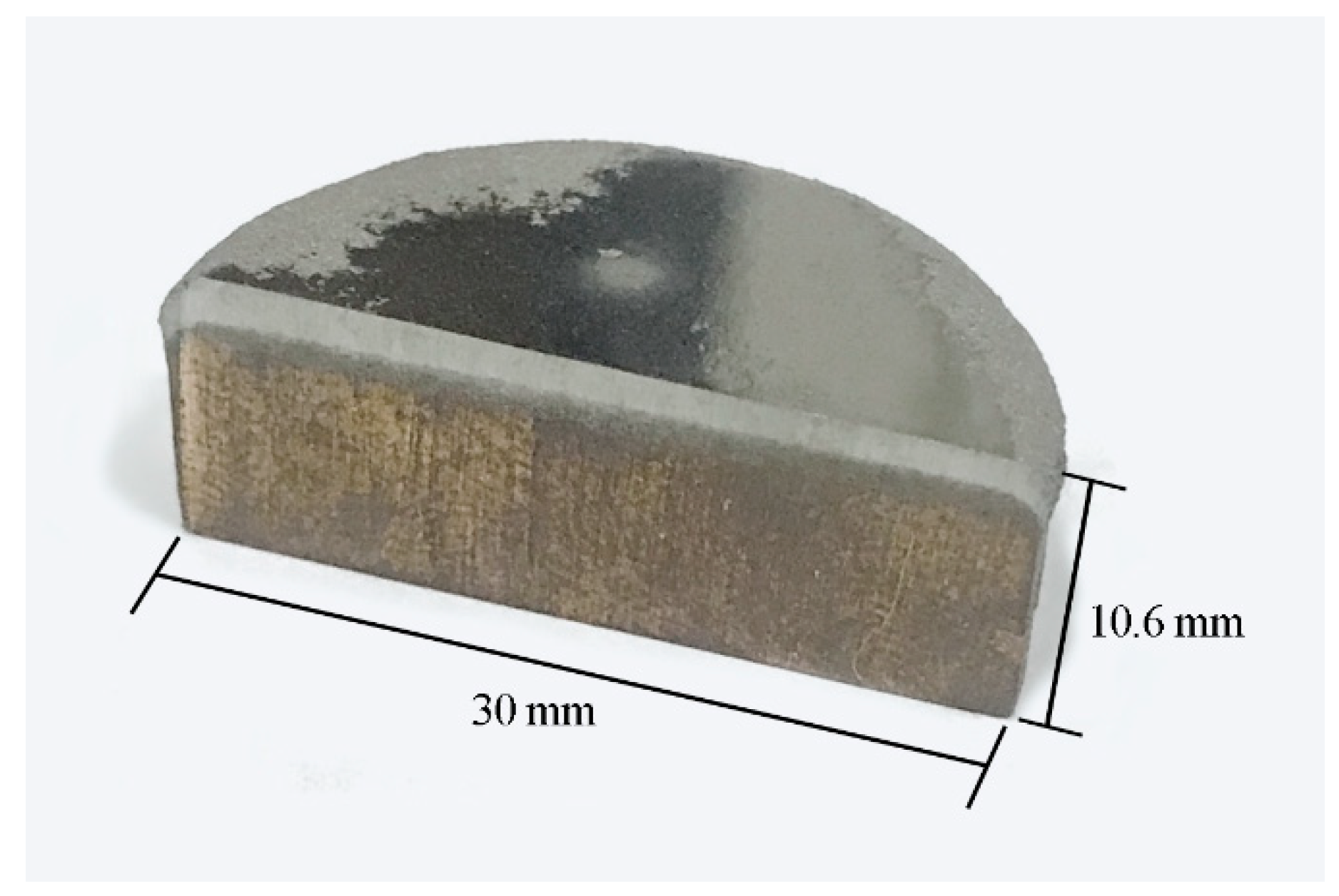
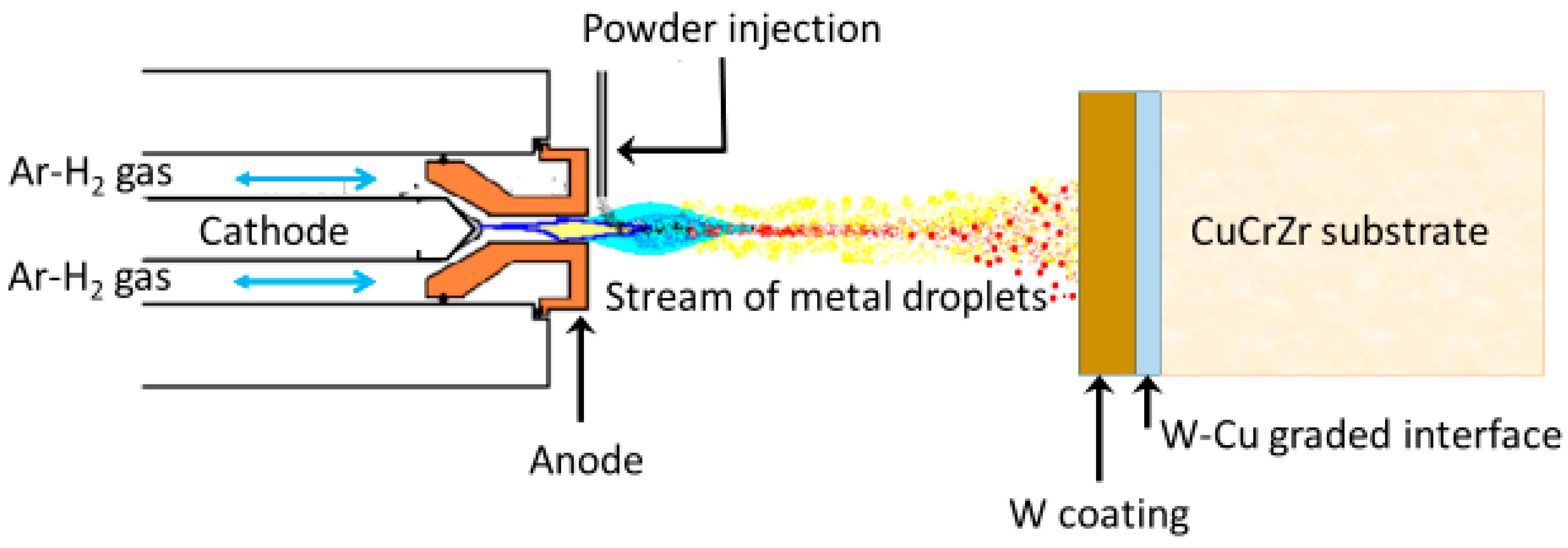
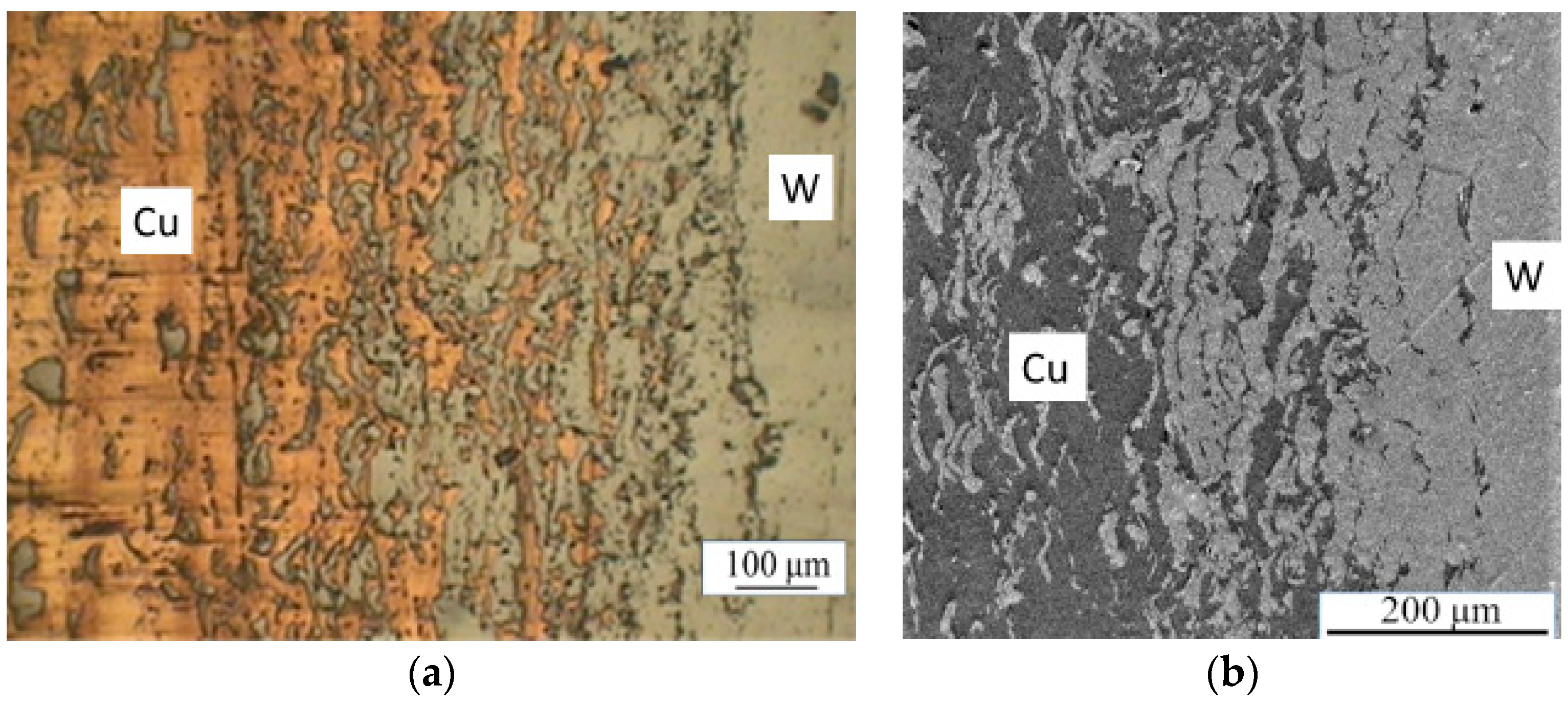

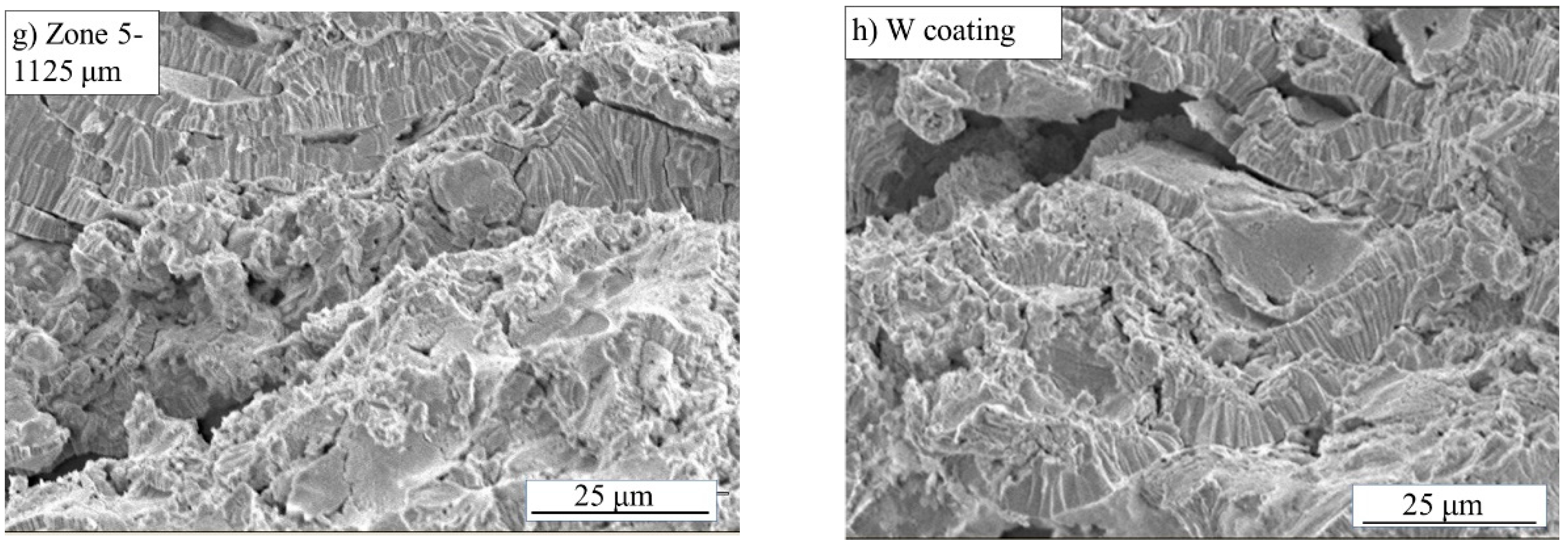
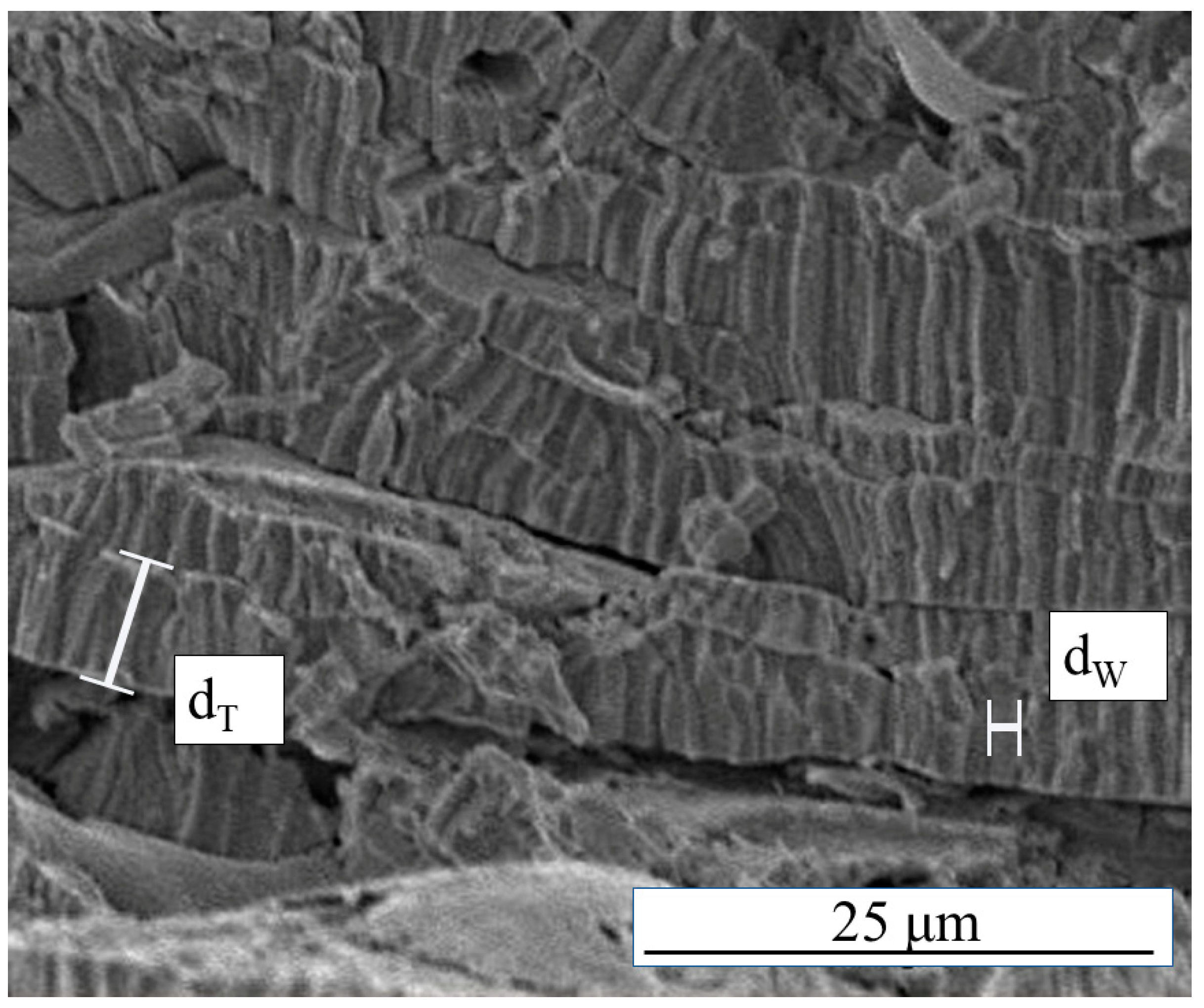
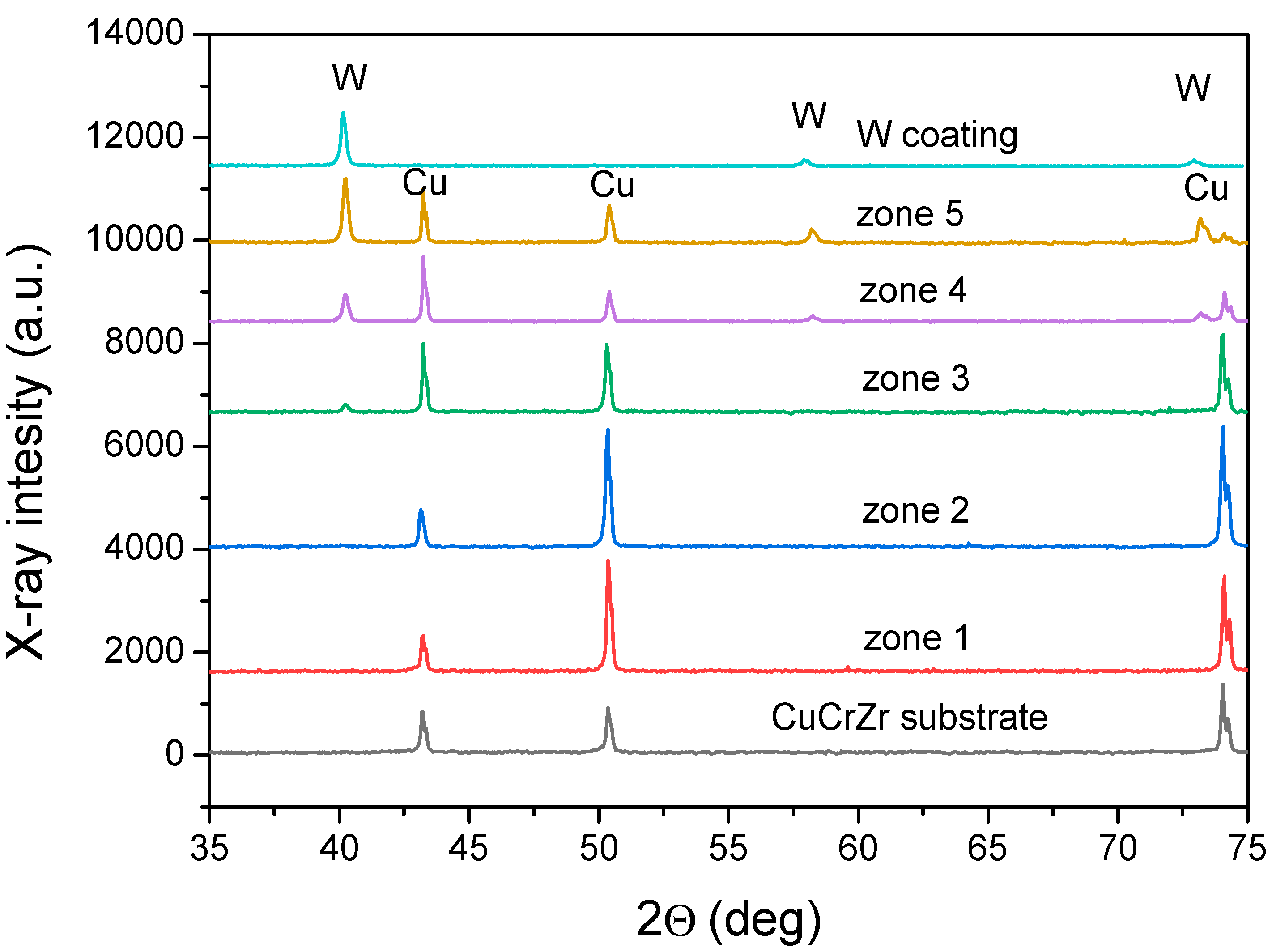
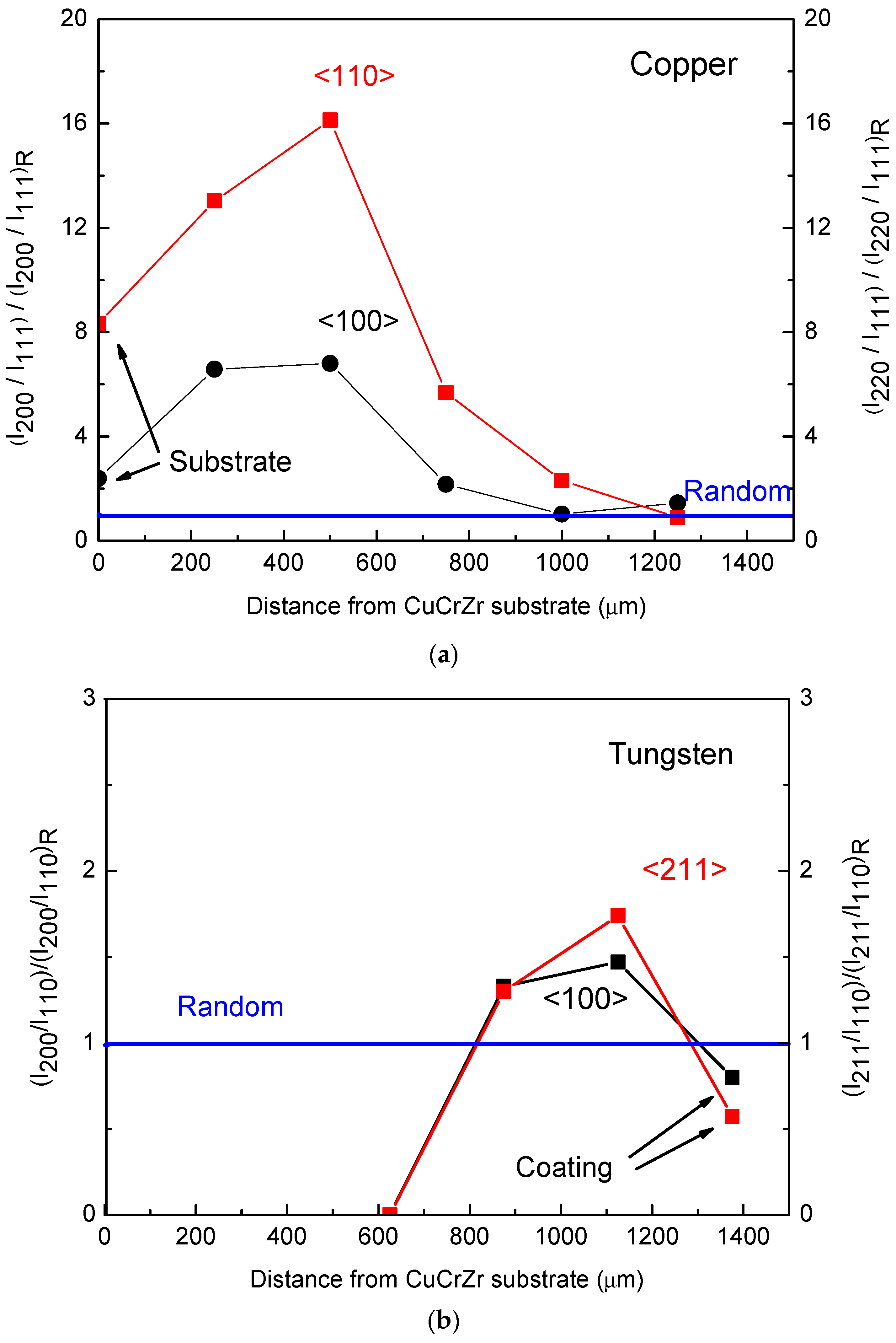
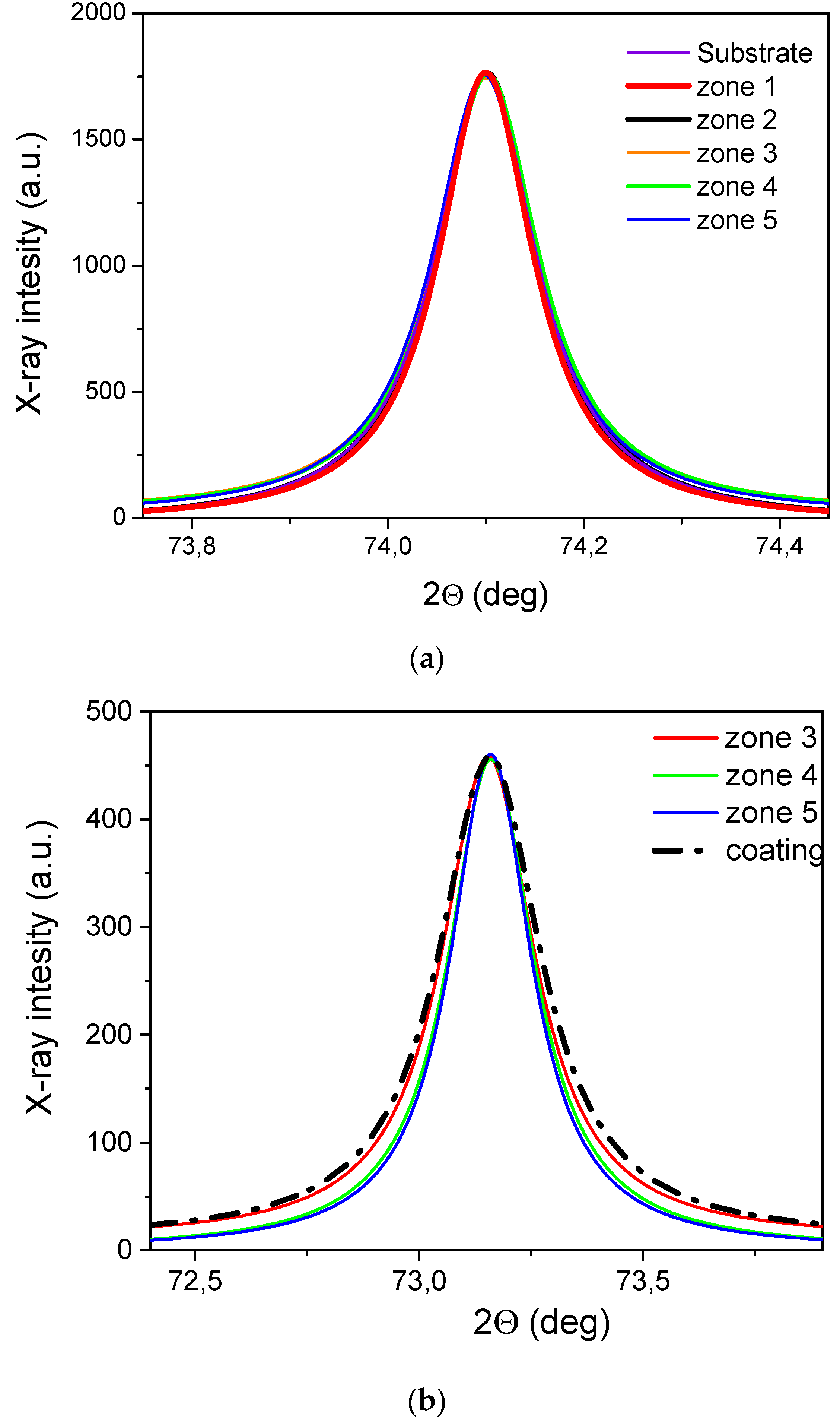
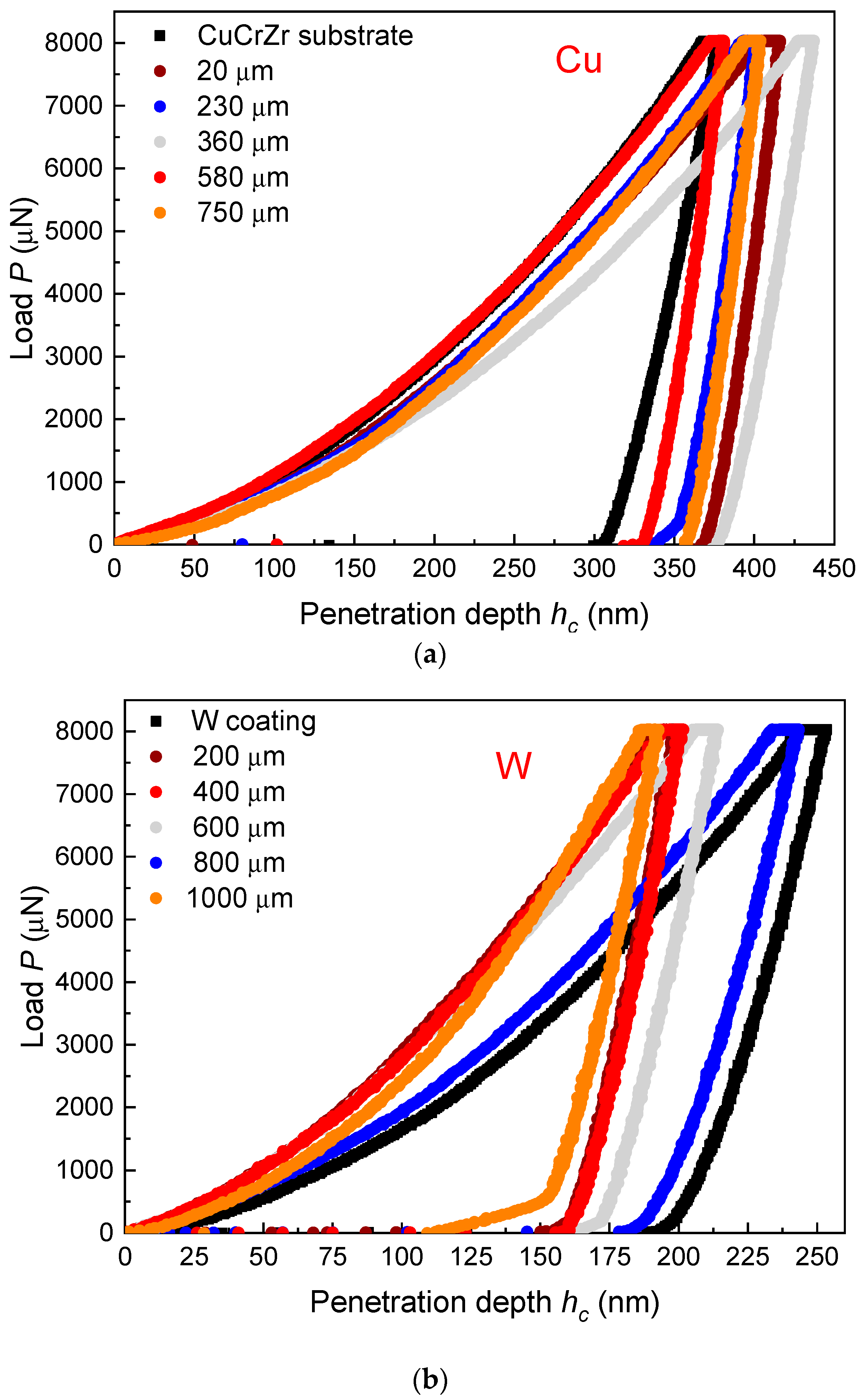
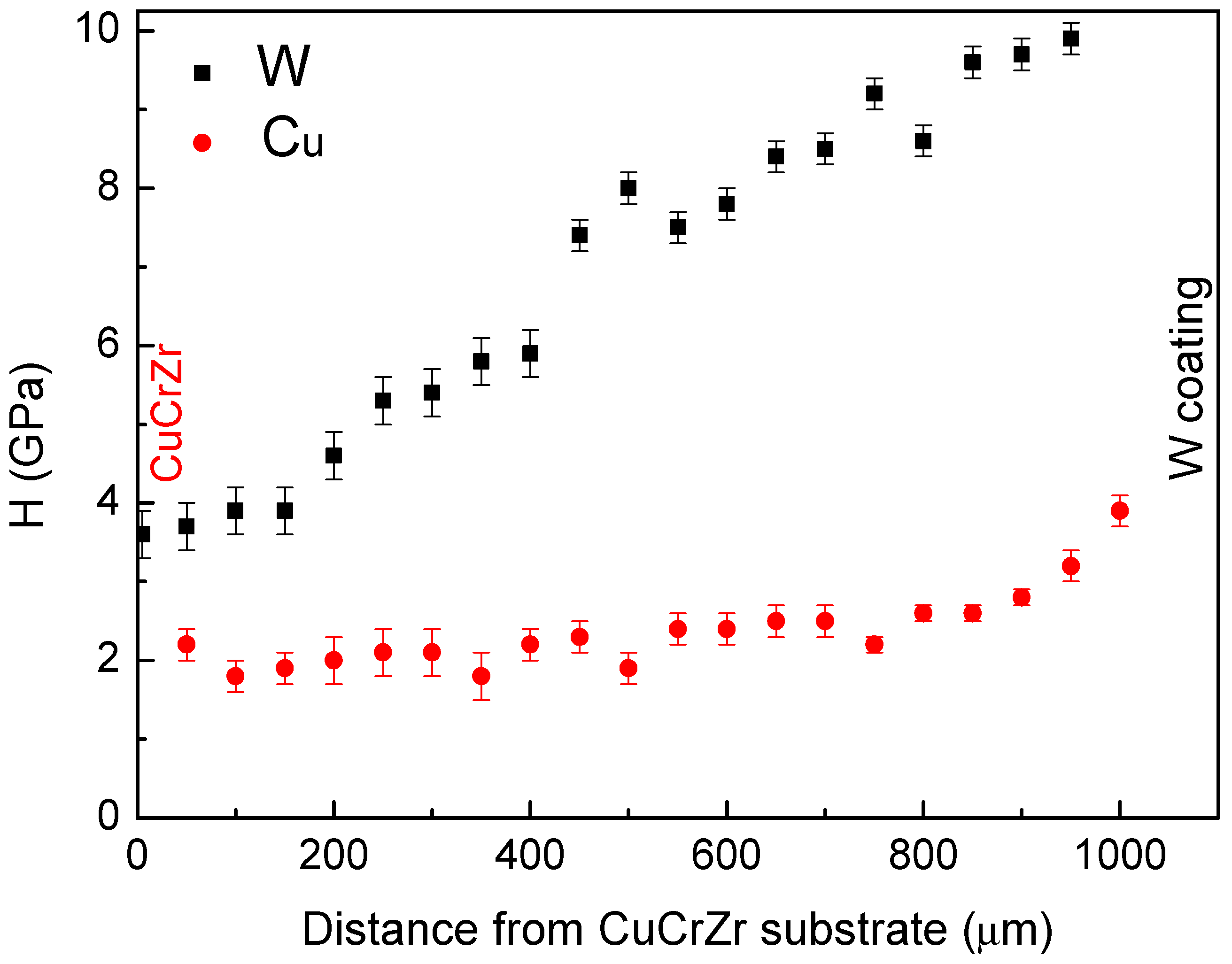
| Deposition Steps | Interlayer Composition | ||
|---|---|---|---|
| Cu vol.% | W vol.% | ||
| Substrate (CuCrZr) | - | - | |
| 1 | 90 | 10 | |
| 2 | 85 | 15 | |
| 3 | 79 | 21 | |
| 4 | 71 | 29 | |
| 5 | 59 | 41 | |
| 6 | 42 | 58 | |
| 7 | 18 | 82 | |
| 8 | 10 | 90 | |
| Coating | 0 | 100 | |
| Tungsten | Copper | ||||||||
|---|---|---|---|---|---|---|---|---|---|
| {110} | {200} | {211} | Texture | {111} | {200} | {220} | Texture | ||
| W-4-806 | 100 | 15 | 23 | Random | Cu-4-836 | 100 | 46 | 20 | Random |
| Substrate | - | - | - | - | Substrate | 60 | 66 | 100 | <110> |
| 1/(125 μm) | - | - | - | - | 1/(125 μm) | 33 | 100 | 86 | <110> |
| 2/(375 μm) | - | - | - | - | 2/(375 μm) | 31 | 97 | 100 | <110> |
| 3/(625 μm) | 100 | - | - | <110> | 3/(625 μm) | 88 | 88 | 100 | <110> |
| 4/(875 μm) | 100 | 20 | 30 | <211> | 4/(875 μm) | 100 | 47 | 46 | <110> |
| 5/(1125 μm) | 100 | 22 | 40 | <211> | 5/(1125 μm) | 100 | 67 | 18 | <110> |
| W coating | 100 | 12 | 13 | <110> | W coating | - | - | - | - |
Publisher’s Note: MDPI stays neutral with regard to jurisdictional claims in published maps and institutional affiliations. |
© 2022 by the authors. Licensee MDPI, Basel, Switzerland. This article is an open access article distributed under the terms and conditions of the Creative Commons Attribution (CC BY) license (https://creativecommons.org/licenses/by/4.0/).
Share and Cite
Cabibbo, M.; Fava, A.; Montanari, R.; Pakhomova, E.; Paoletti, C.; Richetta, M.; Varone, A. Grain Orientation and Hardness in the Graded Interlayer of Plasma Sprayed W on CuCrZr. Appl. Sci. 2022, 12, 1822. https://doi.org/10.3390/app12041822
Cabibbo M, Fava A, Montanari R, Pakhomova E, Paoletti C, Richetta M, Varone A. Grain Orientation and Hardness in the Graded Interlayer of Plasma Sprayed W on CuCrZr. Applied Sciences. 2022; 12(4):1822. https://doi.org/10.3390/app12041822
Chicago/Turabian StyleCabibbo, Marcello, Alessandra Fava, Roberto Montanari, Ekaterina Pakhomova, Chiara Paoletti, Maria Richetta, and Alessandra Varone. 2022. "Grain Orientation and Hardness in the Graded Interlayer of Plasma Sprayed W on CuCrZr" Applied Sciences 12, no. 4: 1822. https://doi.org/10.3390/app12041822
APA StyleCabibbo, M., Fava, A., Montanari, R., Pakhomova, E., Paoletti, C., Richetta, M., & Varone, A. (2022). Grain Orientation and Hardness in the Graded Interlayer of Plasma Sprayed W on CuCrZr. Applied Sciences, 12(4), 1822. https://doi.org/10.3390/app12041822











